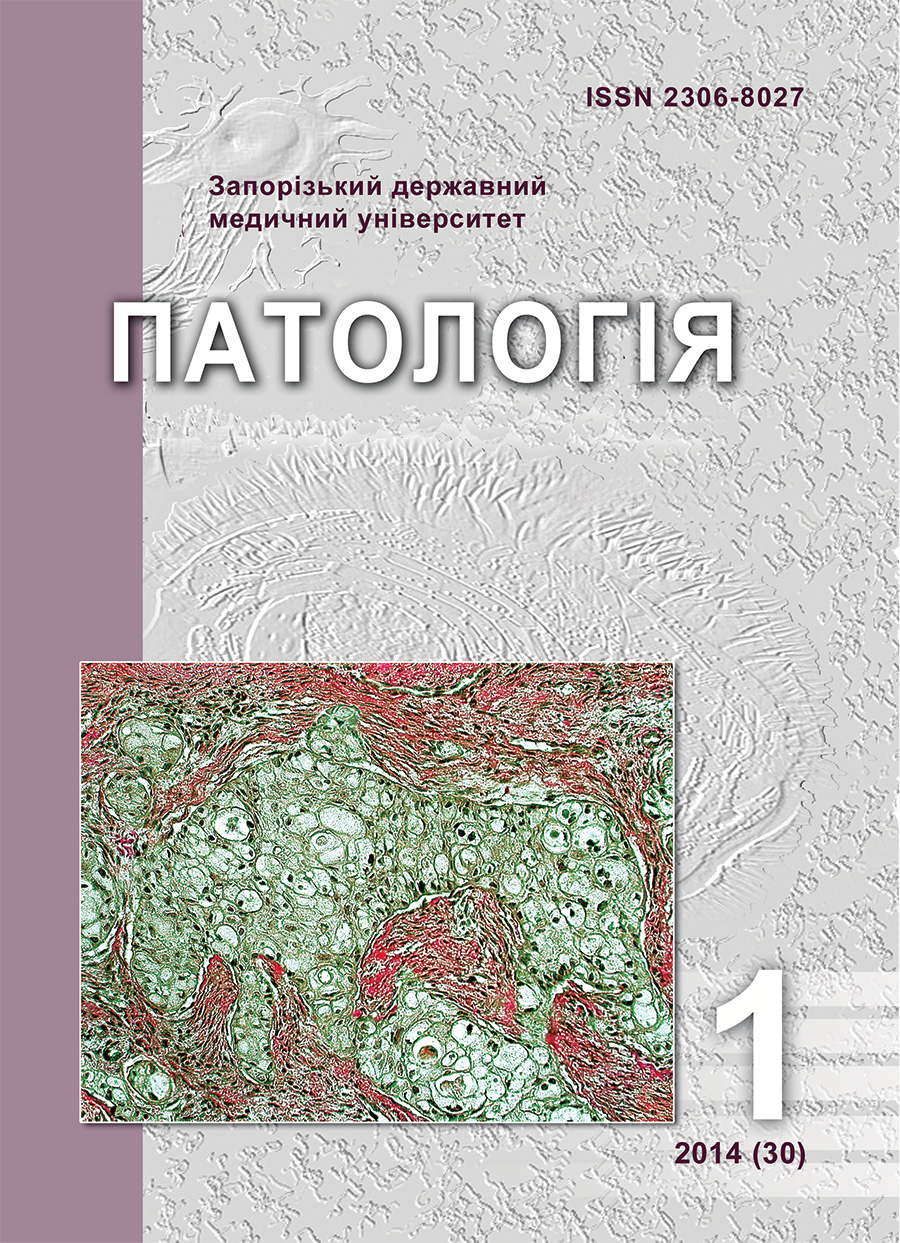Histological and morphometric characteristics of supratentorial meningiomas of the brain
DOI:
https://doi.org/10.14739/2310-1237.2014.1.25412Keywords:
meningioma, nuclear morphometry, cell densityAbstract
The development of modern methods of clinical diagnosis and surgical treatment of CNS tumors necessitates reliable morphological verification of the tumor lesion with the definition of its histogenesis, morphological variant and degree of malignancy. Works on computer analysis of morphometric data of CNS tumors are rare. Meanwhile, histomorphometric studies have potential value for diagnostic purposes in the study of brain tumors.
Goal: to conduct histological and morphometric analysis of the cellular composition of meningiomas, needed to improve their differential diagnosis.
Material and methods. We studied surgically removed meningiomas in 39 patients aged from 40 to 66 years. 7 meningothelial meningiomas, 4 angiomatous, 6 fibrous, 7 transitional, 6 psammomatous, 2 atypical and 7 anaplastic meningiomas were included in the study.
Histomorphometric analysis was performed on hematoxylin and eosin (H&E)-stained histological sections. Calculation of quantitative indices was conducted using a computer system for digital image analysis KS 200 (Kontron Elektronik,Germany, lic. № 0200299). Studied objects (cell nuclei) were examined using morphometric measurements: cross-sectional area (AREA), the diameter of the object (the diameter of irregularly shaped objects was calculated through their equivalent area – parameter DCIRCLE). Coefficients (indices) of the form (FC) and elongation (EC) were used as additional morphometric characteristics of the studied objects.
Results. Meningothelial meningiomas were represented by large cells with light nuclei with diffusely located fine chromatin. Most cells had a polygonal shape and did not have clear boundaries. The cell density in the field of vision averaged 55±5, cross-sectional area of the nuclei 45,24±4,77 µm2, FC and EC respectively 0,87±0,02 and 0,71±0,1.
Transitional meningiomas were characterized by combined areas of meningothelial, syncytial type and areas with typical fibroblastic differentiation of cells. Two groups of cells were identified which differed in morphometric parameters: a cross-sectional area of nuclei, respectively 49,78±5,93 and 30,59± 4,16 µm2 and FC 0,87±0,05 and 0,67±0,10. EC were respectively 0,54±0,13 and 0,43±0,11.
The predominant cell type in fibrous meningiomas were fibroblast-like arachnoendotheliocytes with oval, elongated nuclei containing fine chromatin, hyperchromic nuclei were frequent. Cells formed bundles going in different directions, concentric structures and psammoma bodies were often met. Tumor cell density was 46,6±13,22. In areas with fibrous extracellular matrix cells with cross-sectional area of the nuclei 37,13±4,47 µm2 dominated.
Atypical meningiomas were characterized by increased cellularity – 82 cells in the field of view, more pronounced nuclear polymorphism, mitosis and the presence of small areas of necrosis. The cross sectional area of the nuclei of tumor cells was 65,78±16,97 µm2.
The cross sectional area of the nuclei is significantly increased in atypical and anaplastic meningiomas, which reflects the increase in the degree of atypia (linear relationship between the degree of increasing area of the nuclei and Grade - strong positive correlation, Pearson coefficient r=0,89, p<0.05).
Conclusions. Conducted investigation indicates the feasibility of using a morphometric method for improving the diagnosis of various meningiomas. Prospects for further research in this area suggest the selection of reliable morphometric criteria for estimation of the recurrence rate and aggressiveness of meningiomas growth.
References
Louis D.N., Ohgaki H., Wiestler O.D., Cavenee W.K. (Eds.). (2007). World Health Organization Classification of Tumours of the Central Nervous System. IARC, Lyon.
Commins D.L., Atkinson R. D., Burnett M.E. (2007) Review of Meningioma Histopathology. Neurosurgical Focus, 23(4), E3.
Pennella A., Ferri C., Lettini T., Serio G., Cimmino A., Caniqlia D.M., Gianqaspero F., Ricco R. (2000, February). Atypical meningioma: morphometric analysis of nuclear pleomorphism. Pathologica, 92(1), 25-31.
Sreeshyla H.S., Shashidara R., Sudheendra U.S. (2013, October). Morphometric evaluation of AgNORs in odontogenic cysts. Analytical and quantitative cytology and histology, 35(5), 273-277.
Yap F.Y., Bui J.T., Knuttinen M.G., Walzer N.M., Cotler S.J., Owens C.A., Berkes J.L., Gaba R.C. (2013). Quantitative morphometric analysis of hepatocellular carcinoma: development of a programmed algorithm and preliminary application. Diagnostic and interventional radiology, 19(2), 97-105. doi: 10.4261/1305-3825.
Noy S., Vlodavsky E., Klorin G., Drumea K., Ben Izhak O., Shor E., Sabo E. (2011, June). Computerized morphometry as an aid in distinguishing recurrent versus nonrecurrent meningiomas. Analytical and quantitative cytology and histology, 33(3), 141-50.
Inagawa H., Ishizawa K., Hirose T. (2007, November-December). Qualitative and quantitative analysis of cytologic assessment of astrocytoma, oligodendroglioma and oligoastrocytoma. Acta Cytologica, 51(6), 900-906.
Scarpelli M., Montironi R., Salvolini U., Messori A., Bartels P.H. (2004, April). Karyometric features of low and high grade glial tumors as compared with their MRI appearance. Analytical and quantitative cytology and histology, 26(2), 87-96.
Batoroev Yu. K. Tsytopatologia i gistomorfologia opukholei nervnoi sistemy (Cytopathology and histomorphology of tumors of the nervous system): Dis. … dokt. med. nauk. Irkutsk, 2009, pp 310.
Nafe R., Schlote W. (2004, August). Histomorphometry of brain tumours. Neuropathology and applied neurobiology, 30(4), 315-328.
Boruah D., Deb P. (2013, August 26). Utility of nuclear morphometry in predicting grades of diffusely infiltrating gliomas. ISRN Oncology. doi: 10.1155/2013/760653/ eCollection 2013.
Downloads
How to Cite
Issue
Section
License
Authors who publish with this journal agree to the following terms:
Authors retain copyright and grant the journal right of first publication with the work simultaneously licensed under a Creative Commons Attribution License that allows others to share the work with an acknowledgement of the work's authorship and initial publication in this journal.

Authors are able to enter into separate, additional contractual arrangements for the non-exclusive distribution of the journal's published version of the work (e.g., post it to an institutional repository or publish it in a book), with an acknowledgement of its initial publication in this journal.
Authors are permitted and encouraged to post their work online (e.g., in institutional repositories or on their website) prior to and during the submission process, as it can lead to productive exchanges, as well as earlier and greater citation of published work (SeeThe Effect of Open Access).

